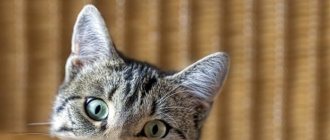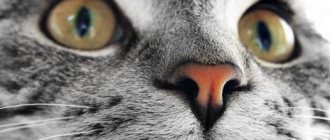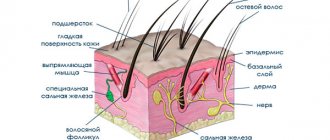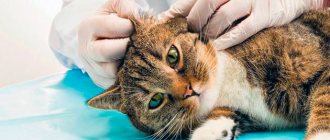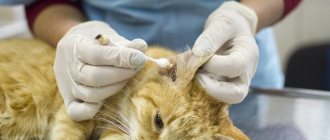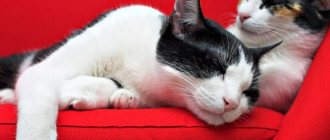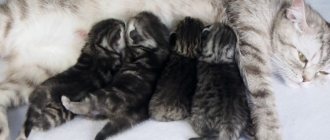Snot in a cat occurs due to the impact of various unfavorable factors on the nasal mucosa, which causes inflammation. Scientifically it is called rhinitis. Special glands begin to secrete protective secretions in much larger quantities than usual. We are accustomed to calling this secretion - a mucous liquid secreted from the nostrils - snot. Sneezing and nasal discharge in a cat can be caused by infectious and non-infectious causes. Depending on this, you need to develop treatment for a runny nose.
Causes
Transparent nasal discharge is a reflex reaction of the body to cleanse itself of the following irritants:
- Infectious – viruses, pathogenic bacteria, helminth larvae.
- Non-infectious - foreign objects and allergens.
If fluid comes out of one nostril, it means a mechanical object has entered it. In case of an allergic irritant, both nasal openings remove dust or block access to the mucous membrane of unpleasant-smelling substances - perfumes, gasoline, tobacco. If you remove the object or interrupt the contact of the cat's nose with the irritant, the discharge will stop.
Rhinitis
Otherwise, pay attention to additional signs. They indicate a contagious disease.
If, in addition to nasal discharge, lacrimation or conjunctival hyperemia occurs, contact a specialist. The probable cause of the pathology is cat flu. Unvaccinated young animals, elderly individuals or those weakened by chronic illnesses suffer.
Rinsing the nasal passages
If a pet cannot breathe normally, this may be due either to the fact that its nose is clogged with dried exudate, or due to swelling and swelling of the mucous membranes. In all these cases, we recommend rinsing the animal’s nose, as this contributes to its speedy recovery. The procedure is not without pitfalls, and therefore we recommend enlisting someone’s help. Rinsing a cat's nose is done as follows:
- The solutions used for washing must be heated to a temperature of approximately 37°C.
- Ideally, you should use the smallest syringe for flushing, but an insulin syringe works well for this purpose. We recommend connecting a tube from a catheter for intravenous injections to its spout. It is thin enough to be inserted into the animal's nostrils.
- After this, the pet must be carefully secured in a lying position. If for some reason you were unable to get an assistant, you can press the cat’s head between your knees.
- When the cat is securely secured, they begin to inject the rinsing solution first into one nostril, then into the other. You can fill no more than 0.5 ml at a time. After each serving, it is necessary to pause so that the pet has time to rest properly.
- At the end of the procedure, it is necessary, using a gauze pad soaked in warm saline, to clean the cat’s face from any remaining washing liquid and exudate.
Treatment
If clear nasal discharge appears, it cannot be eliminated with folk remedies or medications. Treatment is delayed, serous discharge becomes mucous or purulent. Pneumonia or eye disease develops, which ends in loss of vision. Treatment is prescribed by a veterinarian.
There was a delay in seeing a doctor
How to properly use medicinal drops for rhinitis
It is no secret that medicinal drops are most often used to treat rhinitis, as well as to relieve swelling of the mucous membranes and relieve pain.
Using them is much more convenient than constantly rinsing the nose, but... For drip preparations to be truly effective, they must be used correctly:
- The animal needs to be well secured, seated, and then the cat’s muzzle must be raised so that it looks exactly at the ceiling.
- There is no need to stick standard pipettes into your nostrils, as this will almost certainly cause injury to your nose! They must be kept at a distance of a couple of millimeters from the nose and the medicine should be dripped so that it flows directly into the nostrils. In the case when the owner tilts the pet's head vertically upward, there is nothing difficult about it.
- It is unrealistic to cure rhinitis in a day; your pet needs to be accustomed to all the necessary procedures, performing them at the same time, without getting nervous or panicking. If you do everything confidently and calmly, the cat will get used to it and will not resist much.
Prevention
The pet is protected from irritants - dust, tobacco smell, perfumes. Provide balanced nutrition. If a felinologist does not have the skills to prepare a diet from natural products, it is better to use factory-made food. To avoid contracting cat flu, your pet is vaccinated in a timely manner.
Multifel-4
Discharge of clear fluid from the nose indicates that a foreign object has entered the nostrils, an allergic reaction, or a contagious disease. If an alarming symptom occurs, contact a veterinarian. You cannot treat the disease yourself with human medications, as well as folk remedies.
We invite you to join our Zen channel and group on VKontakte or Odnoklassniki, where new articles for pet owners are published.
Similar articles:
- My cat has a nosebleed - what should I do?
- Inflammation of the lower lip in a cat
- Papillomas and warts in cats
Purulent discharge from the nasal passages
Unlike both cases described above, the appearance of pus cannot be explained by physiological reasons. If purulent exudate is released from the cat’s nose, this always indicates the presence of an inflammatory process. The latter may be due to the following reasons:
- The main predisposing factor is always the development of pyogenic microflora in the nasal cavity or in other upper parts of the respiratory system.
- Accordingly, purulent rhinitis is a common consequence of systemic and local infections of bacterial etiology.
- Often accompanied by purulent inflammation, the entry of foreign bodies into the nasal cavity. Their surface almost always contains pathogenic and conditionally pathogenic microflora, so inflammation develops very quickly.
- For the same reasons, pus in the nose can be the result of injury. The mucous membranes are damaged and can no longer serve as a barrier to infection.
- The most dangerous cause of pus is fungal infections of the nasal cavity.
Treatment
Since purulent rhinitis is always a consequence of bacterial contamination of the nasal mucous membranes, a standard treatment regimen is used:
- Broad-spectrum antibiotics are always prescribed. In recent years, drugs from the cephalosporin group are usually used for this purpose. In addition, other antimicrobial drugs may be prescribed.
- It is very advisable to rinse the cat’s nose up to four times a day with a hypertonic solution of table salt, since otherwise the exudate will dry out in the nostrils, preventing the animal from breathing normally.
- The food of a sick animal should have an increased content of vitamins A and E, which promote accelerated regeneration of mucous membranes, as well as zinc (for the same purpose).
- All fur around the nose must be cut off, and any exudate that is released must be removed from the cat’s face as it appears. If this is not done, the skin around the nose will quickly become soft and inflamed (pus is a powerful natural solvent).
Runny nose in cats and why you shouldn’t use nose drops
Cat lovers often encounter or have heard about this problem. “The cat is sneezing!”, “the cat is sniffling!”, “can’t breathe through its nose!”, “some kind of discharge from the nose...” and so on. All these complaints can be combined into one medical term - rhinitis (inflammation of the nasal mucosa). Owners, by analogy with people, say: “I have a cold,” but in fact, in animals everything is much more complicated... A constantly stuffy nose reduces the activity of the animal, due to the loss of smell, appetite worsens, the “taste for life” disappears, so to speak, and some pathologies, accompanied by rhinitis, can even lead to death.
Because rhinitis is not a separate disease, but just a symptom. The task of the doctor and owner is to try to find the cause of rhinitis. Anamnesis (animal medical history, information from the owner), tests and hardware diagnostics can help with this. How to sort through the heap of proposed tests and examinations? It is sometimes difficult even for doctors, but there are points that need to be known.
Colds, we must remember once and for all: there is no such term! Yes, against the background of hypothermia, the protective properties of the immune system may decrease: the animal is more susceptible to viruses and bacteria. But warm-blooded animals have a constant body temperature, which can only be lowered by extreme conditions (falling through the ice, prolonged fasting, dehydration, toxins, blood loss, etc.), but not by an open window or a cold floor.
The main causes of rhinitis in cats:
- Viral diseases . Most often these are calicivirus and feline herpesvirus or infectious rhinotracheitis (IRT). Usually these viruses are not fatal, but they “spoil the blood” of owners and doctors due to their characteristics.
Calicivirus - causes ulcers in the oral cavity, mucous membranes of the lips, nose, causes rhinitis, in rare cases - pneumonia, lameness, skin lesions. The peculiarity of this virus is that it mutates very quickly, so vaccination, unfortunately, does not fully protect against the disease, that is, it protects, but only against the strains (varieties) that are included in the vaccine. To identify calicivirus, the doctor takes a scraping from the oral cavity with a special brush or cotton swab. The procedure is not painful.
Herpes virus (HRT) is a virus that affects 80-90% of the cat population and is transmitted at an early age from the mother. In small kittens it is accompanied by eye damage, in adult cats - by rhinitis. Kittens can even go blind, so treatment cannot be delayed! The peculiarity of this virus is that after the symptoms subside, the herpes virus goes to live in the nervous tissue (trigeminal nerve). And therefore, in some cats, under stress (the arrival of a new family member or pet, moving, repair work), RTI may again become active. Unfortunately, laboratory diagnosis is difficult: swabs from mucous membranes do not always reveal the virus; the cornea or trigeminal nerve is more informative. Due to their invasiveness, such tests are not relevant in practice.
Sometimes owners themselves infect their pets. Veterinarians regularly hear a story: they adopted a kitten that looked healthy, but the house cat got sick. Why is this happening? Because a kitten that has recovered from a viral disease sheds the virus for another 20 days. A newly arrived cat should be separated, ideally to another home. If the possibility is limited only to the provision of a separate room, then when in contact with a sick animal or carrier, gloves, shoe covers, a robe should be used, and all things should be removed when leaving the room.
Treatment consists of rinsing the nose, mouth, eyes, prescribing painkillers and, possibly (prescribed by a doctor), antibiotics. Antibiotics do not kill viruses, they are needed to suppress a secondary infection, which is never the root cause! Sometimes a doctor may prescribe a drug that suppresses the reproduction of herpesvirus, but usually, symptomatic treatment is sufficient. The effectiveness of immunostimulants has not been proven. But there are additional interferences that prevent the immune system from coping with infections. This is feline viral leukemia and immunodeficiency. They affect the very heart of the body - the immune system, so a cat suffering from leukemia or immunodeficiency simply cannot effectively cope with other, less dangerous viruses, despite the diligence of the doctor and owner. Chronic viral infections, also called viral leukemia and immunodeficiency, are difficult to diagnose, so several samples of material are required over a certain period of time.
- Foreign body in the nasal cavity . It seems like how could it get there? And, nevertheless, if you constantly observe discharge from one nostril, you definitely need to do a rhinoscopy. During rhinoscopy, the foreign body will be immediately removed and the cat will recover. It is very disappointing to hear cases where owners decided to undergo rhinoscopy after 2 years of useless treatment, and it turned out that a blade of grass was stuck in the nasal passages. Why don't people want to have rhinoscopy? Because it is a financial burden and anesthesia. The fear of anesthesia dates back to “ancient” times, when there were no veterinary anesthesiologists. In the era of modern equipment and the narrow focus of specialists, there is an anesthesiologist in every clinic, and even more so where rhinoscopy is performed. Obviously, no one wants to pay extra money, but if there are objective indications for rhinoscopy, you shouldn’t delay.
- In older cats, spontaneous discharge from this nostril may be due to a tumor of the nasal sinuses or ear . polyps are sometimes found in young cats . The diagnosis can be confirmed using MRI (soft tissue involvement), CT (bone structures). For the same reason as rhinoscopy, owners do not want to do these studies, very in vain: after all, while the tumor is small, it can be successfully removed, which is not always possible in advanced cases.
- An allergic reaction is extremely rare. Allergies that are accompanied by rhinitis occur at certain times of the year. Small particles such as construction dust can be irritating and cause rhinitis and cough.
- Also, the culprits of a runny nose are teeth and ears. The affected roots of the teeth serve as a source of infection, while the crowns of the teeth that we see may look healthy. For the most part, this is a pathology of older cats (after 10 years). The dentist determines the condition of the roots of the teeth by taking a dental x-ray under sedation . Pus in the middle ear sometimes causes signs of a respiratory infection. There is no way to defeat it with antibiotics; the source of infection must be removed. Diagnostics - otoscopy in the clinic, CT, MRI in complex cases.
So, we’ve come to the main question: WHY YOU SHOULD NOT PUT DROPS INTO A CAT’S NOSE. As you can see, due to a variety of reasons, this is simply not effective. There are no drops that can cure a tumor or reach a foreign body and cope with the virus. They are also not effective in humans. It’s just that the drops reduce the swelling and it seems to us that things are getting better. However, in cats, due to the anatomical shape of the nostrils, drops hardly penetrate. Perhaps most drops do not harm, but by dripping into your pet’s nose, reassuring yourself that you are treating without diagnosing, you are wasting the animal’s precious time.
A few words about treatment.
1. The doctor should tell you approximately when improvement will occur; if it does not, a repeat visit to the veterinary clinic is needed.
- Some drops can be used after rhinoscopy for 3 days to relieve swelling. If used for longer, even greater swelling of the nasal mucosa is possible.
- If there is heavy thick discharge, nasal rinsing is prescribed in the clinic. If regular rinsing does not help, and the discharge is thick, sometimes it is rinsed under sedation (for this you can use 2 liters of saline, with the obligatory installation of a tracheal tube). If the doctor looks at your request with round eyes and a slightly open mouth, go to another clinic.
- Search for the reason. No matter how you want it, you have to! If your runny nose miraculously went away and you treated it with drops, it’s just a coincidence. Without eliminating the cause, after 7 days of taking it, rhinitis will return.
- Follow your doctor's orders, especially antibiotic therapy. Tell your doctor honestly if you have not given or are not going to give antibiotics. You should not change the antibiotic yourself; you should think about changing it if there is no effect after 7 days of use. Another antibacterial drug is usually selected based on culture results.
- In case of illness of the oral cavity, pharynx and a number of other reasons, when the animal does not eat for a long time and force-feeding is impossible, it is better to insert an esophageal tube. A very convenient thing, especially for the animal.
- If the cat suffers from chronic rhinitis (chronic viral infections, herpes virus, seasonal allergies) or after rhinoscopy, you should not spray any aerosols on it or smoke. During repairs, isolate from dust. These actions will prevent exacerbation and worsening of symptoms.
And remember: doctors without the support of the owner will not be able to cure the animal!
Health to you and your animals!
Kitten's nose is stuffy
Kittens, due to unformed immunity and weakened resistance, are susceptible to various viral-bacterial and parasitic diseases. Various pathogenic microorganisms, viruses, fungi, and protozoa can provoke illness in small pets. Infection of kittens occurs transplacentally, during intrauterine development, if the mother cat suffers from an infectious disease or is a latent virus carrier.
Nasal congestion in a kitten can be caused by hypothermia, allergies, severe helminthic infestation, and the presence of foreign objects in the nasopharynx and nasal passages.


